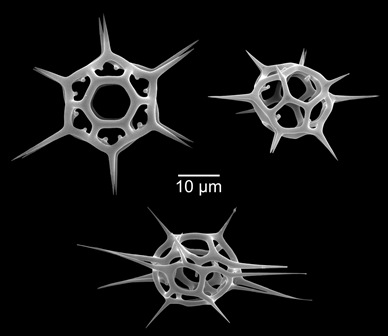Dr. Kevin McCartney, Geology Professor at the University of Maine at Presque Isle, has just returned from attending his second international scientific conference since late August. McCartney, or “Kevin” as he is widely known, traveled to Reston, Virginia to participate in the 14th International Nannoplankton Association conference (INA) during the third week of September. In August, he attended the North American Diatom Symposium in Bar Harbor. McCartney spoke at both meetings about his current research on silicoflagellate double skeletons.
“There are few things as rewarding to a scientist as the attendance of an international meeting,” McCartney said. “International meetings bring the highest caliber scientists in the discipline from around the world, and are a rare opportunity for discussions, stories and camaraderie.”
The International Nannoplankton Association conference was attended by 130 scientists from 25 countries and included both paleontologists and biologists, most of whom study tiny skeletons made of calcite. Nannoplankton refers to very small single-celled algae, less than 10 micrometers, that float in the oceans. McCartney has been a member of the INA for about 15 years and has previously been published in its Journal of Nannoplankton Research. He has two articles in preparation for this journal.
Just a few weeks prior to the INA conference, McCartney attended the 22nd North American Diatom Symposium (NADS) in Bar Harbor, Maine on Aug. 21. The meeting had 92 scientific participants from nine countries. The NADS is a field conference that meets every two years and brings together seasoned and young diatomists.
Diatoms are a significant group of algae with quartz skeletons that live in fresh and marine water and may account for about a quarter of the world’s oxygen. The diatoms have become increasingly important in learning about environmental changes in freshwater lakes and the effects of higher atmospheric carbon dioxide on ocean ecosystems. McCartney attended the symposium four years ago while on sabbatical in Nebraska.
McCartney reported on the research he has conducted on silicoflagellates—which are somewhat larger in size than diatoms and have skeletons made of quartz—found in geologic strata of the Arctic islands of northern Canada and Russia. In these sediments, he has found rare double skeletons, which are two skeletons still together prior to cellular division. He has recently submitted a paper on modern double skeletons to the journal Phycological Research, and has several other papers on the subject in preparation.
McCartney has generally attended a national or international meeting at least once a year ever since he completed his Ph.D. and joined the UMPI faculty in 1988.
